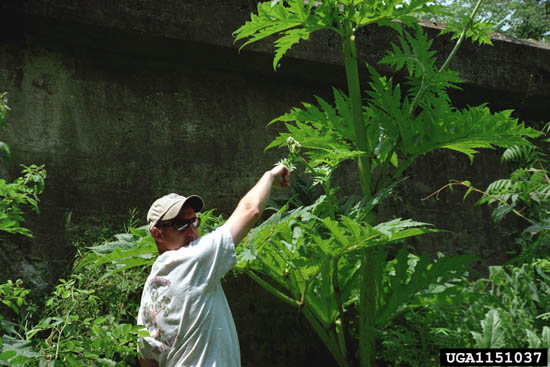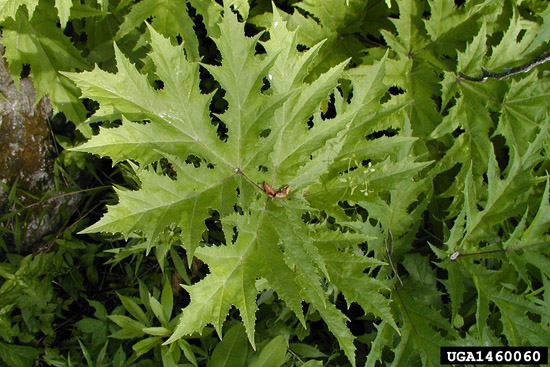Issue 11, July 2, 2009
Invasive Species Spotlight--Giant Hogweed
Giant Hogweed is a recent exotic weed introduced into the Illinois landscape. It can degrade natural landscapes and possesses health risks to people.
Native to the Caucasus Mountain and southwestern Asia, giant hogweed (Heracleum mantegazzianum), has been introduced to Europe, Canada, and the United States. This invasive plant has been confirmed in several states including Maine, New York, Pennsylvania, Washington, Oregon, Michigan, and most recently, Illinois. Giant hogweed was confirmed in Illinois in August 2006 in Lake County. Plants were found by participants in the New Invaders Watch Program, a cooperative program that engages citizens to spot new invasive species that pose a threat to healthy ecosystems. This species is now on the Federal List of Noxious Weeds and illegal to propagate, sell, or transport in the US.

As indicated by its name, this biennial or short-lived perennial can grow between 10 and 15 feet tall. It has enormous compound leaves, up to 5 ft. wide on the bottom sets, with 3 deeply incised leaflets. Thick stems are from 2 to 4 in. thick, hollow and covered in purple blotches and course white hairs. The easiest stage of identification of Giant Hogweed is in its flowering stage. Numerous small white flowers are born in June or July in large flat-topped umbels up to 2½ ft. across. After the flowers produce their seeds by late-summer the plant dies back to the thick taproot. Its stem may persist throughout the winter.

Giant Hogweed belongs in the carrot or parsley family (Apiaceae). It has several look-a-likes, including Cow Parsnip (Heracleum lanatum), Angelica (Angelica atropurpurea), and Poison Hemlock (Conium maculatum)--all common plants found in Illinois. Although many of these plants may look like Giant Hogweed at first glance, none of them get to be as large or have its exaggerated characteristics. Other distinguishing characteristics include hollow stems, between two and four inches in diameter, with dark reddish-purple splotches and coarse white hairs. Leaves are compound, lobed, deeply incised and may grow up to five feet in width. Flowers appear from mid-May through July. As with other members of the carrot family, the flower heads are umbrella-shaped, up to 2½-feet in diameter across a flat top with numerous small flowers.

In addition to being a noxious weed, Giant Hogweed can be harmful to humans. It produces a clear, watery sap that is capable of causing photodermatitis--a sensitivity of the skin to sunlight. The sap produces painful, burning blisters or even painless red blotches that may turn purple over time. It is very important to wear gloves when handling this plant and also to avoid smoke if this plant is being burned nearby.
It is believed that giant hogweed made its way into the United States as an ornamental plant or was brought into the country for its fruit, which is used as a spice in Iranian cooking. Undoubtedly, its unique stature and appearance has enticed gardeners to cultivate this plant. However, due to its size and rapid growth, giant hogweed readily out-competes many native plants. This perennial can survive in a variety of areas, but is common along roadsides, right-of-ways, railroads, vacant lots, streams, and rivers. Once established in an area, it can create a significant decline in biodiversity, increase soil erosion along riverbanks, and is difficult to eradicate. In addition, it often grows in wet areas, and can be considered an invasive freshwater weed.
Giant hogweed is still rare in Illinois. While visitors in natural areas are unlikely to encounter this plant, it never hurts to keep a watchful eye for this and other invasive plants.
For more information, stop by the Illinois CAPS blog for all the latest news on invasive pests in Illinois.--Kelly Estes
Author:
Kelly Estes